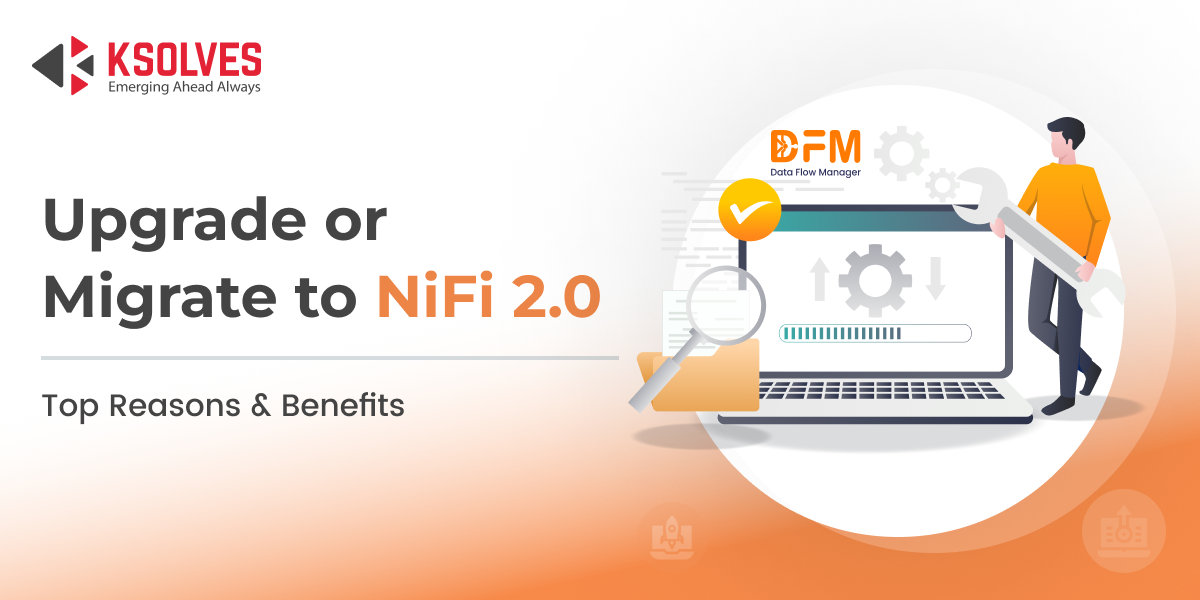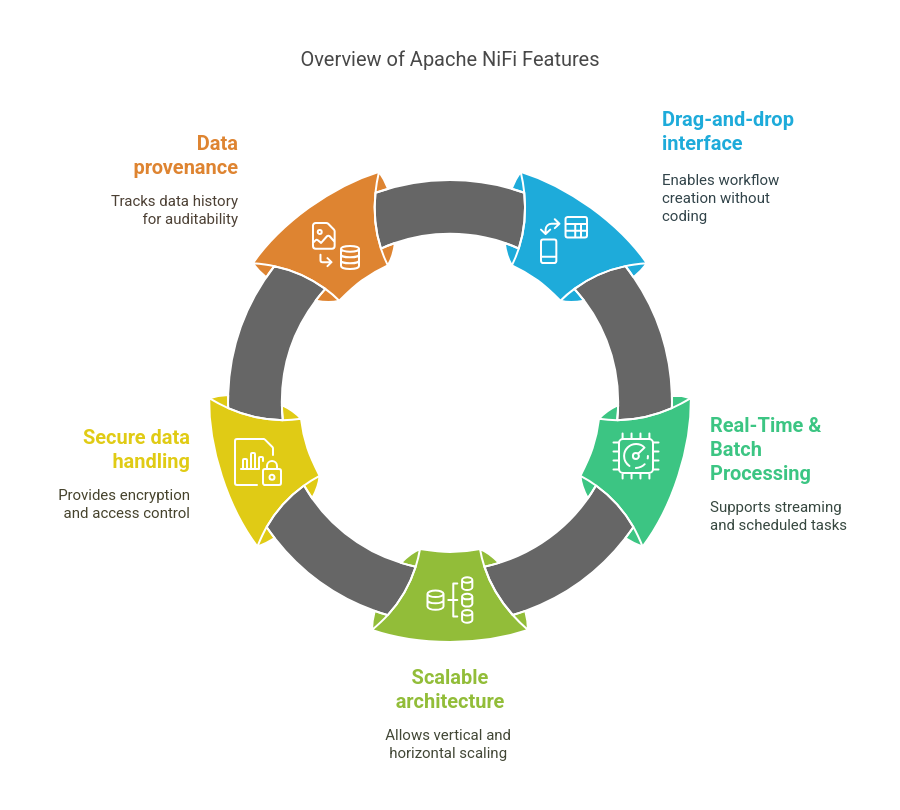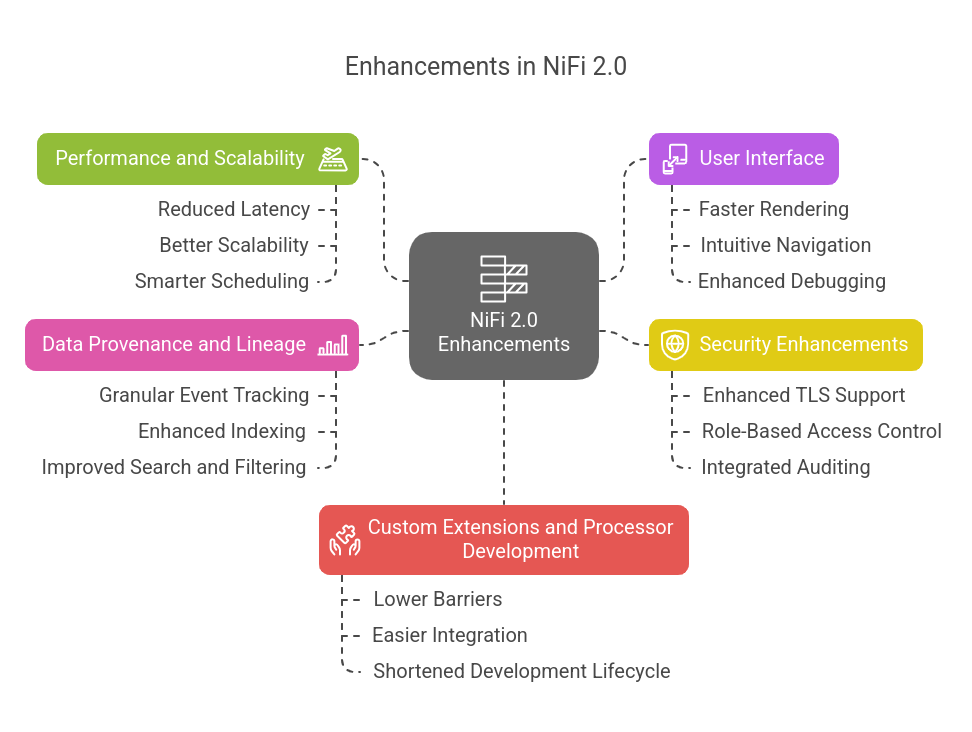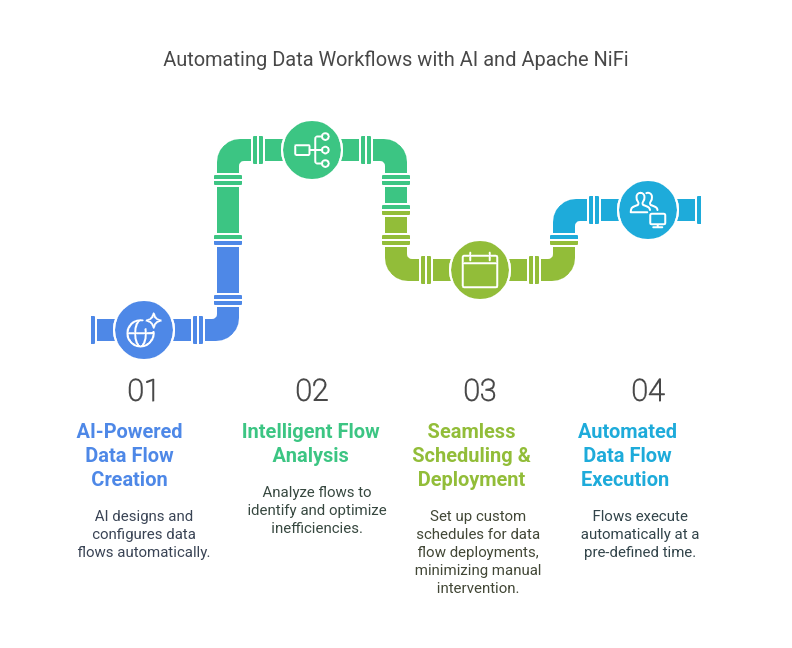Why Use Apache NiFi 2.0? Top Reasons to Migrate or Upgrade to it
![]()

Apache NiFi has emerged has a robust, scalable, and user-friendly platform for data-processing. It is a powerful open-source data ingestion and integration tool and has been a trusted ally for many teams seeking efficient data routing, transformation, and system integration. With the release of NiFi 2.0, the Apache community has introduced a host of updates aimed at improving performance, security, usability, and scalability.
If you’re debating whether to migrate your current data flow operations to NiFi 2.0 – or even adopt NiFi for the first time – this post will walk you through the most compelling reasons.
Below, we’ll explore NiFi’s capabilities, detail new features that set 2.0 apart.
What is Apache NiFi?
Apache NiFi is an open-source data integration and workflow automation tool designed to automate the movement, transformation, and management of data between systems. It provides a visual, drag-and-drop interface to design data flows, making it easy to route, process, and distribute data across various platforms.

Key Features of Apache NiFi:
- Drag-and-drop interface: Allows data engineers to create and manage complex workflows without extensive coding.
- Real-Time & Batch Processing: Supports both real-time streaming and scheduled batch workflows.
- Scalable architecture: NiFi can be scaled vertically (on a single server) or horizontally (across a cluster) to handle large data volumes.
- Secure data handling: Offers encryption, authentication, and access control for sensitive data.
- Data provenance: Maintains a detailed history of every data record’s path and changes, ensuring better auditability and traceability.
Why Upgrade to NiFi 2.0?
1. Enhanced Performance and Scalability
One of the most significant reasons to migrate to NiFi 2.0 is the improved performance architecture. While NiFi 1.x already handled high throughput well, 2.0 refines resource utilization with better thread management and load balancing. This translates to:
- Reduced latency during peak workloads.
- Better vertical and horizontal scalability—easier to grow your NiFi cluster as your data needs evolve.
- Smarter scheduling that distributes tasks effectively across cluster nodes.
2. Updated User Interface
NiFi has always prided itself on a user-friendly, drag-and-drop design canvas. In 2.0, the UI has been streamlined for better responsiveness and usability. Notable changes include:
- Faster rendering of complex data flows.
- More intuitive navigation across the NiFi canvas.
- Enhanced debugging capabilities, making it simpler to identify potential bottlenecks and misconfigurations in real time.
These improvements help both new and experienced NiFi users ramp up quickly and maintain more clarity in data flow design.
3. Robust Security Enhancements
With the growing importance of data security and privacy, NiFi 2.0 packs additional authentication and encryption enhancements to ensure data is protected end-to-end.
Key highlights include:
- Enhanced TLS support for securing communications within and across NiFi clusters.
- Fine-grained role-based access control (RBAC) improvements, enabling you to assign explicit permissions to different user groups and components.
- Integrated auditing that supports compliance needs by logging all access and configuration changes.
Whether you’re handling sensitive financial data or personal user information, these security features help you maintain high compliance standards.
4. Advanced Data Provenance and Lineage
The ability to track data through every stage of its lifecycle is a core strength of NiFi. Version 2.0 expands these capabilities with:
- More granular event tracking that provides in-depth detail about transformations and routing decisions.
- Enhanced indexing for high-volume environments, making it easier to query and locate historical events.
- Faster and more comprehensive search and filtering functionalities within the provenance repository.
Such improvements solidify NiFi’s status as a top choice for organizations that need trustworthy, auditable data pipelines.
5. Simplified Custom Extensions and Processor Development
NiFi’s extensibility has always been a strong suit. In 2.0, the process of creating custom processors is smoother, with clearer documentation and updated templates that minimize boilerplate code.
These changes:
- Lower barriers to create specialized data transformations and connectors.
- Make it easier to integrate NiFi with proprietary or niche systems.
- Shorten the development lifecycle by providing out-of-the-box scaffolding.
For organizations with unique use cases, this streamlined development environment can prove invaluable.

Why Migrate from Older to New Versions?
1. Long-Term Support and Community Momentum
As with any major software upgrade, the community focus shifts toward the newer version. NiFi 2.0 will likely be where most bug fixes, security patches, and new features appear first.
By migrating:
- You’ll stay in sync with the primary support base.
- Benefit from a larger number of community-contributed processors and improvements.
- Reduce the risk of running on an outdated version that may not receive critical fixes.
2. Compatibility with Modern Technologies
NiFi 2.0’s updates ensure better integration and compatibility with new technologies:
- Cloud-native orchestration systems like Kubernetes and Docker.
- Modern data platforms, messaging queues, and event streaming systems (e.g., Apache Kafka, RabbitMQ).
- Emerging data standards and protocols that require up-to-date libraries.
Staying current helps ensure you can leverage the latest data frameworks without complex workarounds.
3. Performance Gains for Big Data Workloads
For organizations pushing NiFi 1.x to the limit with large-scale data flows, the performance enhancements in NiFi 2.0 can be a game changer. Reduced resource contention, improved cluster management, and more intelligent thread allocation all contribute to smoother data pipelines—particularly important for:
- Real-time analytics
- High-frequency data ingestion
- Large cluster deployments that need failover and dynamic scaling
4. Minimizing Technical Debt
Running older versions indefinitely can accumulate technical debt. As features age, administrators and developers must spend extra time maintaining or tweaking solutions to stay operational.
Upgrading to NiFi 2.0:
- Simplifies ongoing maintenance by making the system easier to configure and, enabling you to monitor.
- Reduces unforeseen bottlenecks that often arise from outdated software components.
- Provides improved up-to-date documentation and official guidance.
Streamline Your Data Workflows with Data Flow Manager
Data Flow Manager provides full-stack support for NiFi 2.0, allowing organizations to streamline data workflows while taking full advantage of the latest NiFi capabilities.
Key Benefits of Data Flow Manager for NiFi 2.0:
- Manage and optimize NiFi 2.0 clusters effortlessly.
- Deploy data flows with a single click.
- Schedule the deployment of data flows with minimal manual effort.
- Real-time monitoring, logging, and alerts to stay informed about performance, bottlenecks, and potential issues.
- Strengthen governance with role-based access control.
By leveraging Data Flow Manager, businesses can automate, monitor, and optimize their NiFi 2.0 workflows, ensuring efficient and scalable data processing.
Data Flow Manager Streamlines Data Workflows with AI & Apache NiFi

Managing data flows has never been easier! Follow these four simple steps to automate and optimize your workflows effortlessly:
Step 1: AI-Powered Data Flow Creation
Let AI design and configure your data flows—no manual setup, just smart, automated orchestration!
Step 2: Intelligent Flow Analysis
Analyze the generated flow to identify inefficiencies, optimize performance, and eliminate bottlenecks.
Step 3: Seamless Scheduling & Deployment
Set up a custom deployment schedule to ensure your data flows run at the right time with minimal intervention.
Step 4: Automated Execution & Monitoring
Your scheduled flows execute automatically and in real-time, ensuring seamless, error-free operations with continuous monitoring.
Conclusion
NiFi 2.0 builds upon the reliable foundation established by its predecessors and provides improvements in speed, security, and ease of use. For organizations dealing with ever-increasing data volumes, evolving compliance requirements, and integration challenges, upgrading to NiFi 2.0 offers a forward-looking solution.
By embracing the latest release, you position your data infrastructure to handle modern workloads more efficiently while staying aligned with an active open-source community. Whether you’re a seasoned NiFi user or someone exploring a powerful data flow management platform for the first time, NiFi 2.0 offers a compelling set of reasons to make it your go-to choice.
![]()